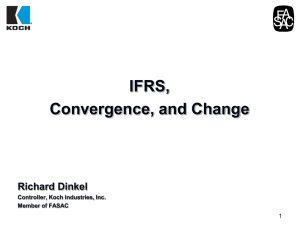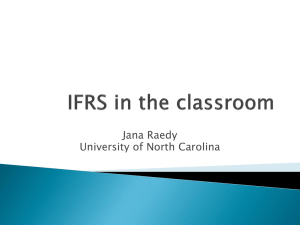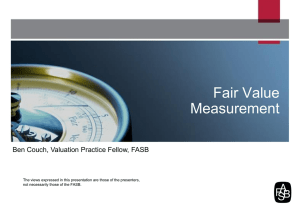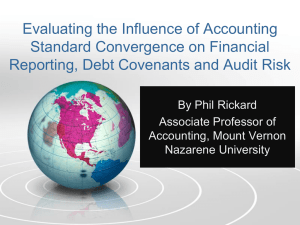The possible ways of global comparability of financial statements in
advertisement
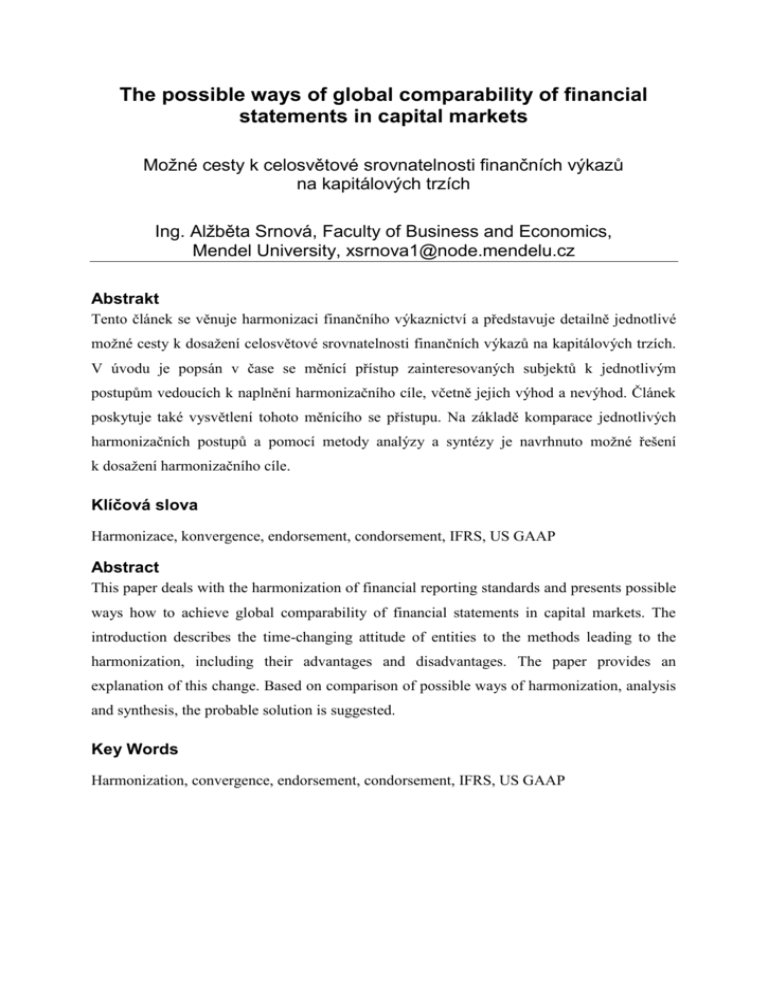
The possible ways of global comparability of financial statements in capital markets Možné cesty k celosvětové srovnatelnosti finančních výkazů na kapitálových trzích Ing. Alžběta Srnová, Faculty of Business and Economics, Mendel University, xsrnova1@node.mendelu.cz Abstrakt Tento článek se věnuje harmonizaci finančního výkaznictví a představuje detailně jednotlivé možné cesty k dosažení celosvětové srovnatelnosti finančních výkazů na kapitálových trzích. V úvodu je popsán v čase se měnící přístup zainteresovaných subjektů k jednotlivým postupům vedoucích k naplnění harmonizačního cíle, včetně jejich výhod a nevýhod. Článek poskytuje také vysvětlení tohoto měnícího se přístupu. Na základě komparace jednotlivých harmonizačních postupů a pomocí metody analýzy a syntézy je navrhnuto možné řešení k dosažení harmonizačního cíle. Klíčová slova Harmonizace, konvergence, endorsement, condorsement, IFRS, US GAAP Abstract This paper deals with the harmonization of financial reporting standards and presents possible ways how to achieve global comparability of financial statements in capital markets. The introduction describes the time-changing attitude of entities to the methods leading to the harmonization, including their advantages and disadvantages. The paper provides an explanation of this change. Based on comparison of possible ways of harmonization, analysis and synthesis, the probable solution is suggested. Key Words Harmonization, convergence, endorsement, condorsement, IFRS, US GAAP Introduction The globalization of capital markets, the increase in the number of multinational companies, the removal of institutional barriers, improvement of competitiveness and increasing amount of cross-border trade of goods and services have made the financial world riskier for investors. When taking into account the fact that individual states have their own national accounting systems that provide external users with different information, there is a need to create compatible and understandable information sources. The harmonization of financial reporting standards of publicly traded companies could become the right source of information for inventors. Lack of quality, complete, comprehensive and comparable information may lead to the investors’ bad decision with negative consequences not only for investors but also for the capital markets, as well as the economy as a whole. Establishment of a harmonized high quality, compatible set of financial standards which would be applicable to both national and cross-border reporting is required solutions. Development of a single - global system of financial reporting standards would help investors to obtain reliable information about the financial situation of the enterprise, eliminating the need for conversion of national standards and in the end it may lead to an increase in the international capital flow which would give companies better access to capital through lower interest rates. The introduction of harmonized reporting rules would allow companies entering new foreign markets with lower costs and would lead to increasing international competition in global markets. (Pologeorgis, 2013) Objectives and methodology The main goal of this paper is an evaluation of the changing attitude to harmonization of the financial reporting system and introduction of the possible ways how to achieve the globally accepted standards with their advantages and disadvantages in details. The article also describes the cause of this change which is mainly visible by US entities. On the basis of the analysis, the goal of the paper is to draw up the most probable solution which could aim at the desired harmonization. For introduction of the time varying approach to harmonization and presentation of the possible ways how to achieve it, the description method is used in the article. The paper also uses method of comparison which allows comparing each specific harmonizing procedure. On the basis of this comparison, the analysis and the synthesis suggest a solution to achieve harmonization objectives. During the work on this paper, the studies carried out by the leading international consultancy companies PricewaterhouseCoopers (PwC), Ernst & Young and Deloitte were used. Road Map of SEC, Work Plans, public statements and documents of Financial Accounting Standards Board (FASB), International Accounting Standards Board (IASB) and Securities and Exchange Commission (SEC) were also analyzed. The researches of the PricewaterhouseCoopers (2011) and the American Institute of Certified Public Accountants (2010) were important for the analysis. Theoretical backgrounds It is possible to identify several ways how to achieve the global harmonization of financial reporting standards. There is a method of convergence of the most significant financial reporting systems, endorsement – adoption of one type of standard to a second one and very recently discussed condorsement that represents the merger of two previous methods. Each of these ways has its strengths and weaknesses. The convergence of two of the world's largest financial reporting standards IFRS (International Financial Reporting Standards) and US GAAP (General Accepted Accounting Principles) belonged to the fundamental ways of achieving the desired harmonization aimed at international comparability of financial statements, undoubtedly. The International Accounting Standards Board (IASB) is responsible for the development of IFRS. IFRS represent world-wide standards applied across the continents. For US GAAP, reflecting the unique American environment is a key institution Financial Accounting Standards Board (FASB). It is important to remind the important role of the Securities and Exchange Commission (SEC), the governing body of US financial markets and the American Institute of Auditors (AICPA). The mentioned systems of financial reporting, IFRS and US GAAP, are based on different approaches. US GAAP is known as the rules-based system, supplemented by detailed explanatory materials and IFRS can be considered an accounting system based on common principles. Although it may seem at first glance that the financial reporting standards IFRS and US GAAP are more different than similar, the opposite is true. The general principles and conceptual framework are often the same or similar in both sets of standards, leading to similar accounting results. The existence of any differences - and their materiality to an entity's financial statements - depends on a variety of specific factors (Ernst & Young, 2011). Need for a global system of financial reporting, the proximity of the two most widely spread sets of financial reporting standards - IFRS and US GAAP and a large number of nonUS companies registered at the SEC was one of the main impulses leading to the initiation of cooperation between the IASB and the FASB to develop a globally accepted financial reporting system. The cooperation on the convergence of IFRS and US GAAP began in October 2002 by Norwalk agreement. (FASB, 2002) The signature of the Norwalk Agreement in 2002 was the beginning of cooperation between the IASB and FASB with the aim to develop harmonized high-quality financial reporting rules leading to comparability of disclosures in the financial statements of companies around the world. This comparative information subsequently would help investors to understand better investment opportunities. The desired goal should be achieved through joint projects in the short and long term. Both Boards agreed to carry out these projects in parallel and coordinated way. When signing Norwalk agreement, FASB also emphasized that in case of significant differences between IFRS and US GAAP which are many, it is expected that the solution would be obtained by choosing between current US GAAP and IFRS. It should be a balanced cooperation of IASB and FASB towards a common goal. At the beginning of the convergence process most professionals, participants in the capital markets and companies themselves on both sides of the Atlantic Ocean found the convergence as a positive and important step in meeting the desired goal - to simplify the comparability of the financial statements based on globally accepted high quality standards. In the case of international companies with a large number of branches and subsidiaries in different countries, the idea of integrated accounting and reporting procedures for whole company which enables them to reduce the costs associated with the transformation of the financial statements was the driving force to support the convergence. Since 2005 all companies listed at stock exchanges in the European Union have compulsory prepared their financial statements in accordance with IFRS. In Memorandum of Understanding in 2006, built on Norwalk agreement, the IASB and FASB reaffirmed their commitment to continue in convergence of financial standards. Their commitment was strengthen by creating a time schedule of the convergence process, called as Road Map for 2006 - 2008. In the time schedule the specific "– milestones -" that should be met by 2008, were set. An important consequence of the ongoing convergence process was that the SEC, the US capital markets regulator, decided in 2007 that all non-US company registered in the United States wouldn’t have to submit their financial statements to US GAAP anymore if their financial statements were based on IFRS issued by the IASB. This change was related to roughly 1,150 of 12,000 companies registered at the Securities and Exchange Commission, (Delloite, 2008). At that time, the SEC published a Road Map containing the potential adoption of IFRS for US companies with effective date 2014. In the document, among other things, SEC explains that it has long expressed its support for a single set of high - quality global financial standards as an important means of enhancing comparability and believes that IFRS has the potential to provide the best common platform on which companies can report and investors can compare financial information. (SEC, 2008) The SEC also said that according to the Work plan from February 2010, it would make a detailed analysis of IFRS. The results of the analysis would serve as a basis for the SEC's final decision on adoption of IFRS to US GAAP or not. The analysis would focus on the ability to IFRS become the only standards of financial reporting in the United States, the continuity and development of IFRS, the influence of adoption on other areas of economic and legal environment - for example, the Tax Code of the United States of America, the future role of the FASB and the readiness of professionals and all stakeholders in the capital markets. (KPMG, 2010) The experts, investors and representatives of large multinational companies reacted to the Road Map by sending Comment Letters to the SEC. In these letters they consistently expressed their support to develop global high quality financial standards. However, there were differences in future role of IFRS in the American environment. In several Comment Letters the doubt about applicability of IFRS in USA, which is necessary for the continuation of the harmonization efforts, appeared for the first time. The proposed timetable and costs connected to transfer of US GAAP to IFRS were one of the most criticized points of the Road Map. Other concerns directed to the establishment of the international body responsible for issuing the standards also for USA in the future. There is a question if the body would be able take into account the specifics of the American environment when issuing or modifying standards. In parallel with the described activities of the SEC, FASB and IASB continued work on joint projects. The most important projects with the greatest impact on reporting became the leasing, financial instruments and income recognition (PricewaterhouseCoopers, 2011). In response to the disclosure of the Road Map by the SEC in 2010 American Institute of Certified Public Accountants (AICPA) made a survey of 1,620 companies - US Public and Private Companies, Foreign Private and Public Companies, Non Profit Companies and Public Companies Practice. The research was mainly focused on the familiarity of companies with IFRS and the relationship to the SME (Small and Medium Enterprise). One of the questions was whether the SEC should require the adoption of IFRS into the US environment. The responses were nearly same across different types of companies. Most companies agreed with the adoption of IFRS but only after the process of convergence between IFRS and US GAAP would be finished (see Fig. 1). Speed of the changes was for 37% of respondents too fast but only 5% of respondents considered the change too slow (see Fig. 2). 1: Adoption of IFRS to USA, Source: AICPA What do you thing of the pace of recent standard - setting activity? Too fast Just right 25% Too slow Not sure 37% 5% 33% 2: Pace of recent standard - setting activity 1, Source: AICPA Less than a year later, in 2011, consultant - company PricewaterhousesCoopers made an extensive research related to the convergence of IFRS and US GAAP among representatives of companies differed in size, business and income. 85% of companies came from the United States. Comment Letters sent to the SEC in response to the issue of the Road Map showed criticism about the speed of the convergence which was considered very fast especially by American small and medium - sized companies. The PricewaterhousesCoopers’s research confirmed that almost half of the respondents found the convergence process too fast (see Fig. 3). Compare to the numbers of AICPA’s research, it can be seen an increase in both extreme responses. A big disadvantage of convergence effort was its cost effectiveness. 67 % of respondents agreed in a study conducted by PwC that convergence may lead to an increase in the quality of IFRS and US GAAP (see Fig. 4). Nevertheless excessive financial costs were not expected to be offset by the benefits. This is a strong argument against convergence process (see Fig. 4). Among correspondents substantially prevailed opinion that IFRS would be adapted to the American environment in the future, only the date of adoption was different (see Fig. 5). What do you thing of the pace of recent standard - setting activity? Too fast Just right Too slow Not sure 14% 15% 43% 28% 3: Pace of recent standard - setting activity 2, Source: PwC Will convergence improve quality of US GAAP and IFRS and achieve convergence? The quality willy improve 10% 30% 23% 37% The qualitywill improve but cost does not justify the improvements No need for these projects US GAAP enough quality 4: Improvement of US GAAP and IFRS, Source: PwC Do you believe IFRS will eventually be adopted in the US? 8% 16% YES - in 2015 12% YES - in 2016 23% YES - after 2016 No 41% Not sure 5:Adoption of IFRS to USA Source:PwC In May 2011 the SEC published staff paper "Exploring a Possible Method of Incorporation which included a more detailed framework for the possible inclusion of IFRS into the US reporting system but also for the first time presents officially the idea of "condorsement ". As the name implies, the condorsement is link of endorsement approach and convergence. Mr. Beswick (Deputy Chief Accountant, SEC) was the first one who introduced officially this approach. Under this approach, US GAAP would continue to exist. The FASB and IASB would work to finish their joint projects converge. After completing their joint projects, FASB would work to converge US GAAP to IFRS over a period of time for standards that are not on the IASB's Work plan. At the same time, FASB would have a process to consider new standards issued by the IASB for incorporation into US GAAP. The new standards could be incorporated into US GAAP with or without US modifications. The condorsement approach would allow FASB to retain control over US GAAP. (Parks, 2011) In the middle of July 2012, the SEC issued the document commenting the ongoing convergence efforts. In this document, the SEC says that based on the analysis the differences between IFRS and US GAAP are greater than initially was expected. It also confirmed that IFRS could be generally considered as high quality standards of financial reporting but on the other hand there are areas which are underdeveloped. So, it is impossible to say that IFRS are so much better and more transparent standards than US GAAP. But what is missing in the document is an expectation of the SEC about rejection or acceptance of IFRS (when) into the US environment. 2002 Norwalk agreement 2005 IFRS for listed companies in EU 2007 SEC non-US companies in USA financial statements under IFRS 2011 SEC Staff Paper „condorsement“ 2012 SEC IFRS a US GAAP bigger differnces than was supposed 2006 Memorandum of Understanding 6: Timeline of harmonization process, Source: Own work Discussion and Results The analysis of the time changing approach to the global harmonization of financial reporting standards clearly confirmed that the idea of global high quality standards providing the required comparability of financial statements is still alive. The way how to achieve this goal is changing mainly according to attitude of the important US entities to adoption process of IFRS into the US environment. And what are the current situation and the attitude of representatives? IASB and FASB continue in the convergence process. The four most important current projects include leasing, revenue recognition, financial instruments and insurance contracts. Each of these projects is at a different level of preparation. Some of the projects are in the process of Exposure draft or Re-exposure draft, another one is closed to release the final standard. Nowadays, in the United States the most often mentioned approach is neither convergence nor full adoption of IFRS into the US environment but it is condorsement. Especially small local companies do not agree with adoption of IFRS in the USA because of the high costs that would be associated with it. Contrary, large companies with international branches see in it a way how to reduce the costs that otherwise would have to be spent on the transformation of financial statements prepared in accordance with IFRS to meet the requirements of US GAAP. Development of a single reporting language would bring international companies significant benefits. If the language was IFRS, these benefits would be even greater. In the context of costs of the endorsement, it is important to realize that reporting under IFRS in the European Union applies only to the companies listed on stock exchanges in the European Union, other companies can disclosure information in their financial statements accordance with national standards. In the USA the situation is different. All American companies regardless of their size are required to follow the rules set by US GAAP. It is obvious that the adoption of IFRS would affect a huge number of companies, including small and medium-sized enterprises. Even if convergence is losing its supporters, there are several advantages that could bring with. Firstly the convergence could help to increase the transparency, comparability, clarity and possible simplification. Negative attitude to convergence may be based on a general reluctance to take part in a collaborative process with someone who comes from different cultural, political and economic system or from the society based on different values. Convergence is also faulted for focusing only on the largest differences between current IFRS and US GAAP and the smaller are overlooked. (Pologeorgis, 2013) The opposition to the endorsement among key American institution could come from the fear to lose power under issuing the standards of the USA. However, it is important that these opponents realize that the other economically developed countries in the world have slowly adopted IFRS as its financial reporting standards. It would probably be a mistake for the USA as an important market remains isolated. In recent years, the IFRS, at least to some extent, have been adopted by several large economies - such as China, Russia and Canada. At this moment, the most likely way to achieve harmonization objective is condorsement. It is possible to expect that the FASB and IASB will finish gradually the joint projects and the USA will so far keep their standards with key role of FASB. After that, the new possible common way to develop global standards will be looked for. Although the convergence process has not been successful in all that it was set at the beginning - for example in the conceptual framework, in other projects (e.g. leasing, revenues recognition and financial instruments) have achieved some success. Despite the negative American attitude to the adoption of IFRS to US GAAP, American environment will be strongly influenced by IFRS standards incurred as a result of joint convergence projects in the coming years. Conclusion There is a general consensus that the development of global, high quality and internationally accepted standards of financial reporting is very important but difficult task. The aim of harmonization is to develop high quality and compatible international financial standards applicable to both domestic and cross-border financial reporting to allow greater comparability and transparency of financial reporting, better access to capital and reduce the costs associated with the transformation of statements. It has already been several years since cooperation began. During this period, intensity of cooperation and an attitude of American institutions, professionals and the companies themselves to the ways of harmonization have changed. Even though the convergence project have been invested by large amounts of effort and money, it can’t be expected accordance to present attitudes especially from US entities that the convergence will be fully filled, at least to the extent and timeframe, which was initially expected. A similar situation exists in the case of endorsement method. The opposition to adopt IFRS could come from, inter alia, a general unwillingness to accept anything from other groups coming from different cultures and values, which pays twice in USA. The current most important task of harmonization efforts is to find a way to achieve all desired harmonization objectives with minimal impact on the markets of the United States of America and maintain the influence of the SEC and FASB so that this way could be acceptable for the USA. Taking into account the last SEC’s document published in 2012, current attitude of Americans representatives and the other facts, in my opinion we cannot expect a global comparability of financial statements in the next five years but in the much longer term. References AICPA.IFRS Readiness Tracking Survey. [online]. 2010 [cit. 2013-10-16]. Dostupné z: http://www.aicpa.org/research/studiesandpapers/downloadabledocuments/ifrs%20readiness% 20survey%20--fall%202010%20--%20public%201013.pdf DELLOITE: US Securities and Exchange Commission (SEC).. IASPlus: Resources [online]. 2008 [cit. 2013-10-15]. Dostupné z: http://www.iasplus.com/en/resources/regional/sec ERNST & YOUNG: US GAAP versus IFRS: The basics [online]. 2011[cit. 2013-10-10]. Dostupné:http://www.ey.com/Publication/vwLUAssets/US_GAAP_v_IFRS:_The_Basics/$FILE/US%20GAAP %20v%20IFRS%20Dec%202011.pdf FINANCIAL ACCOUNTING STANDARDS BOARD. International Convergence of Accounting Standars - A Brief History. ONLINE. 2002 [CIT. 2013-10-16]. DOSTUPNÉ Z: HTTP://WWW.FASB.ORG/JSP/FASB/PAGE/SECTIONPAGE&CID=1176156304264 FINANCIAL ACCOUNTING STANDARD BOARD [online]. 2008 [cit. 2013-10-10]. Dostupné z: http://www.fasb.org/intl/convergence_iasb.shtm KPMG: SEC Issues a Work Plan to Evaluate Potentially Incorporating IFRS into the U.S. Financial Reporting System [online]. 2010 [cit. 2013-10-15]. Dostupné z: http://www.kpmg.com/CN/en/IssuesAndInsights/ArticlesPublications/Newsletters/DefiningIssues/Documents/Defining-Issues-O-1002-09.pdf PARKS, Paul. IFRS Adoption, Convergence or Endorsement?. AICPA: IFRS Resources [online]. 2011, xx [cit. 2013-10-16]. Dostupné z: http://blog.ifrs.com/2011/01/ifrs-adoptionconvergence-or-endorsement.html POLOGEORGIS, Nicolas: The Impact Of Combining The U.S. GAAP And IFRS. Investopedia [online]. 2013 [cit. 2013-10-10]. Dostupné z: http://www.investopedia.com/articles/economics/12/impact-gaap-ifrs-convergence.asp PRICEWATERHOUSECOOPERS, 2011 US GAAP convergence & IFRS survey: How companies are preparing for convergence between US GAAP and IFRS [online]. April 2011 [cit. 2013-10-10]. Dostupné z: http://www.pwc.com/en_US/us/issues/ifrsreporting/publications/assets/2011-US-GAAP-IFRS-survey.pdf SECURITIES AND EXCHANGE COMMISSION: Roadmap for the potential use of financial statements prepared in accordance with international financial reporting standards by U.S. issuers. [online]. 2008 [cit. 2013-10-10]. Dostupné z: http://www.sec.gov/rules/proposed/2008/33-8982.pdf



